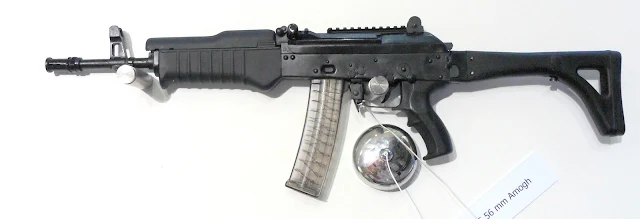To gain a better understanding of the development of assault rifles worldwide, five short examples will follow, all collected from various countries.
By Cadet Patrik
Backlund
General Jonas
Žemaitis Military Academy of Lithuania
There are about
875 million small-caliber weapons currently in circulation worldwide. Over a
thousand companies manufacture them in approximately one hundred countries. All
countries, and a large number of independent armed groups, deal with small
arms. The international website that monitors small arms, Small Arms Survey,
estimates that their annual world trade exceeds 8.5 billion dollars.
There is a large
global market for assault rifles. Many armed forces need new weapons when their
old ‘cold war’ equipment starts to break down. This leads to the main issue of
this paper; what does the future assault rifle look like? Accurate assessments
are very difficult to make. Many countries do not want to publicly disclose the
size of their production, export and import of arms. Analyzing the illegal
activities is even more difficult. The trade in weapons is usually done
illegally through black markets in poor countries. Corruption and illegal seizure
is common in the arms trade.
Assault rifles
are categorized as small caliber weapons. The Swedish Armed Forces define all
weapons below 20 mm as small caliber weapon. Currently, the global development
of new variants of assault rifles continues and the defence industries are
doing business around the globe. Customers demand low prices and high quality.
Developing a good weapon that can then be sold to several countries will
provide an excellent income for the industry. To gain a better understanding of
the development of assault rifles worldwide, five short examples will follow,
all collected from various countries.
French Assault
Rifle Program:
The French army
is currently one of Europe's largest armies. For many years their standard
weapon has been the FAMAS rifle, and as a NATO country their standard weapon
uses 5.56 mm ammunition. The French assault rifle is old; consequently. They
are planning to replace it with a more modern one. France has no industry that
manufactures small arms; therefore, they are forced to look abroad to the
international market.
Image Attribute: FAMAS
They are interested in finding a weapon with a "Bullpup",
a weapon with a design that makes an inserted magazine come closer to the shaft
to reduce recoil, just like their old FAMAS. France intends to order about
90,000 weapons that will start to be delivered as early as 2017. Their goal is
that by 2019 they will have 21,000 weapons that should be operational in their
army units. A competition among weapons industries for the French contract is
expected to start later this year.
Russian Assault
Rifle Program:
The large
Kalashnikov Company in Russia has implemented a major reorganization and has
started to develop new weapon technologies, including a new assault rifle. They
want to increase production and expand their market by finding new places in
the world. Mikael Kalashnikov, who is the famous designer and creator of the
classic AK series, died last year and the production company has been
shattered, but it is expected to produce approximately 150,000 weapons
annually, thus they need to increase their productivity.
Their new rifle,
called the AK12, is currently being adopted by the Russian Army. They are
presently carrying out tests on the gun. For Kalashnikov, India is their most
promising market, where they expect to sell a large number of guns to India’s
Armed Forces.
Image Attribute: AK-12
Image Attribute:
AK-12 with a Drum & GP-30 Grenade Launcher
The Russian army has said that they do not need any new assault
rifles because they have a large stock of old weapons that have not been
used.10 Russia’s military industry, especially their small-calibre parts, has a
very large capacity, but in order to develop they need private investment and
managers, says Sergei Chemezov, director of Rostecs which owns 49% of the
shares in the Kalashnikov Company.
A very
interesting new rifle development was presented to the former president of
Russia, Dmitry Medvedev, during a military exercise named Zapad in 2009. It was
a prototype of the ADS, a new rifle designed especially for Russia's marine
infantry and Spetsnaz forces.
Image Attribute: Russian ADS
The uniqueness of the compact underwater weapon
ADS is that, unlike its bulky predecessor APS, it is exclusively manufactured
for an amphibious environment. The APS rifle with its 150 mm long nails
ammunition is very good at shooting underwater, but not above water. It is
specifically designed for combat divers and has a bullpup design with the
magazine close to the shoulder.
Canadian Assault
Rifle Program:
On the other
side of the globe, the Canadian company Colt is on its way to develop different
sensors on their assault rifles. They are trying to attach several types of
systems to the Colt Infantry Assault Rifle (IAR), such as laser rangefinders, GPS and other
surveillance systems.
Image Attribute: Colt Infantry Assault Rifle (IAR)
They are currently testing several prototypes to see how
they work in practice. The rifle has many interesting electronics, but the
screen kit on the rifle looks more or less like an ordinary Smartphone.
Vietnamese
Assault Rifle Program:
Israel Weapon
Industries, IWI, has opened new weapons factories in Vietnam. Vietnam People's
Army wants to replace their old Russian AK-47s with new Israeli Galil ACEs.
Galil was awarded the government contract in Vietnam and will manufacture the
weapons on site to gradually phase out the old Kalashnikov.
Image Attribute:
Black Galil ACE rifle with adjustable, side-folding stock and Pictainny rails
Vietnam is now the
second country to make a big order from the Israelis. They have previously just
equipped the Colombian army with 19,000 assault rifles. Vietnam's cooperation
with Israel Weapon Industries has long been known and senior officials from
Vietnam visited the Israeli manufacturing plant two years ago.
Indian Assault
Rifle Program:
The Indian Army
is fast-tracking the development and induction of the indigenously designed
Excalibur 5.56 x 45 mm assault rifle as it looks to plug a major operational
void. Once approved, the army plans to induct over 600,000 Excalibur for around
INR36 billion (USD541 million), or around INR60,000 each.
Image Attribute: INSAS Excalibur
The army opted
for the Excalibur after scrapping its 2011 tender for 66,000 multi-caliber assault rifles in June, as none of the four foreign models tested met its
qualitative requirements.
The Excalibur is
a retrofitted version of the Indian Small Arms System (INSAS) assault rifle,
designed by India's Defence Research and Development Organisation (DRDO) and
rejected by the army in 2010 for being "operationally inadequate". The
gas-operated, fully automatic rifle has a foldable butt, Picatinny rail for
sights, sensors, and bipods, and its polycarbonate magazine is superior to that
of the INSAS rifle, which was known to frequently crack in extreme hot and cold
climates. The Excalibur's barrel is 4 mm shorter than that of the INSAS and its
hand guard is smaller.The OFB aims to begin series producing Excalibur on
modified INSAS production lines at Rifle Factory Ichapore (RFI) in 2016 .
Image Attribute: INSAS Amogh Carbine Concept
Meanwhile, the
army has still to decide the outcome of the 2010 tender for 44,618 close
quarter battle (CQB) carbines, trials for which concluded in 2013. These
featured Beretta's ARX 160, IWI's Galil ACE carbine, and Colt's M4.
The Indian Army
has been without a carbine since 2010 when it removed the licence-built
Stirling 1A1 9 mm sub-machine gun from service.
Future Trends:
There are
several examples of weapons that were regarded as innovative in the market and
had features not seen before in the world.
For example, the
first practical breech-loading gun was developed by Samuel Pauly, a Swiss
gunsmith in 1808. The breech-loading gun is still a major feature of firearms
and he is considered the father of shotguns with his drop-down barrel and firing
a self-contained cartridge.The Germans presented something similar when it
comes to inventions for guns during World War II when they built an addition to
their MP44 that allowed them to shoot around corners. But they didn’t use it
for urban warfare in the cities. They used it to keep their vehicles safe from
approaching enemies around them. This invention was way ahead of its time and
would not be developed further until the beginning of the 2000s when a small
Israeli company took over the idea.
Many of today’s
modern soldier systems have the ability to shoot around corners. It is achieved
by equipping the weapon with a video camera and the shooter watching a small
screen to see where he's aiming. This system is very efficient in urban
warfare, but the downside of this system is the cost. It also requires a
transfer of the picture through a cable or radio, and this is extra weight for
the soldier to carry. The Swedish company Aimpoint has developed a simple
solution to the problem. They used a periscope and two mirrors that the soldier
can attach behind his ordinary sight on the weapon. The periscope can rotate in
both directions.
Small arms have
been the soldier's main weaponry for hundreds of years and will continue to be
so far into the future as well. Over the past two decades, many countries
changed the calibre of their assault rifles; they changed from 7.62 mm to 5.56
mm. This led to the weight and volume of ammunition being cut in half, so guns
have become on average one kilogram lighter.
The 5.56 caliber used by NATO is low weight ammo and the soldiers can carry more ammo compared
to bigger calibers, but still be light and handy, which is of great importance,
especially in a battle in urban environments. The 5.56 caliber has weak recoil,
allowing soldiers to quickly shoot a second and a third time to ensure the
effectiveness with the target. It is important to reduce the overall weight
that soldiers carry to make them as efficient and quick as possible on the
battlefield. This, of course, includes their weapons. As mentioned earlier in
the paper, this is a possible improvement point for the Swedish assault rifle.
Modern assault
rifles are manufactured from steel, aluminum and plastic, these materials will
also be standard in the future for cost reasons. Some weapons, such as the G36
rifle, have replaced much of the material in the major parts from metal to
plastic. It also depends on what the user wants; making the handle and pistol
grip in plastic will save weight, but decrease weapon stability when
accessories are attached, such as laser sights and other optics.
Image Attribute : H&K G36 Assault Weapon
Modern rifles on
the market today are all equipped with a rail for attaching accessories; it is
different on different weapons, but in the future NATO will be able to standardize it.
There is a trend
today to use the red dot sights and holographic sights rather than telescopic
sights, which are becoming less popular every year. It is perhaps due to the
large availability of sharp shooting guns and sniper rifles. The same trend
applies to assault rifles with short barrels. Britain and Canada are the
exception; their barrels are longer and they have the same rifle for vehicle
crews. It is popular to have a weapon that is handy to have inside a vehicle
and at urban warfare situations when you need to move in compact areas
There has not
been much technological development with assault rifles in recent years, but
much has happened with the accessories: night vision sights, holographic
sights, different grips, flashlights, laser sights, attachable grenade
launchers or small shotguns.
About The Author:
Cadet Patrik
Backlund, General Jonas Žemaitis
Military Academy of Lithuania
Publication
Details:
This article was
written by the Cadet Patrik Backlund as a Bachelor Thesis titled “ Assault
Rifles : Comparison, Analysis and Future Trends” in Military Technology at General
Jonas Žemaitis Military Academy of Lithuania.




























